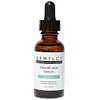What's inside
What's inside
 Key Ingredients
Key Ingredients

 Benefits
Benefits

 Concerns
Concerns

No concerns
 Ingredients Side-by-side
Ingredients Side-by-side

Water
Skin ConditioningGlycerin
HumectantNiacinamide
SmoothingSodium Chondroitin Sulfate
Skin ConditioningMethylglucoside Phosphate
Skin ConditioningCopper Lysinate/Prolinate
Skin ConditioningGlycosaminoglycans
EmollientBambusa Vulgaris Leaf/Stem Extract
HumectantPisum Sativum Extract
Skin ConditioningGlucosamine Hcl
Sodium Hyaluronate
HumectantPanthenol
Skin ConditioningPhenoxyethanol
PreservativeEthylhexylglycerin
Skin ConditioningPolysorbate 20
EmulsifyingDisodium EDTA
Water, Glycerin, Niacinamide, Sodium Chondroitin Sulfate, Methylglucoside Phosphate, Copper Lysinate/Prolinate, Glycosaminoglycans, Bambusa Vulgaris Leaf/Stem Extract, Pisum Sativum Extract, Glucosamine Hcl, Sodium Hyaluronate, Panthenol, Phenoxyethanol, Ethylhexylglycerin, Polysorbate 20, Disodium EDTA
Water
Skin ConditioningGlycereth-7 Triacetate
EmollientPropanediol
SolventNiacinamide
SmoothingPentylene Glycol
Skin ConditioningBetaine
HumectantGlycerin
HumectantSodium Polyacryloyldimethyl Taurate
Emulsion StabilisingLactic Acid/Glycolic Acid Copolymer
Skin ConditioningCopper Palmitoyl Heptapeptide-14
Skin ConditioningHeptapeptide-15 Palmitate
Skin ConditioningHyaluronic Acid
HumectantPalmitoyl Tetrapeptide-72 Amide
Skin ConditioningFerulic Acid
AntimicrobialAcetyl Tetrapeptide-2
Skin ConditioningHydrolyzed Soy Protein
HumectantRice Amino Acids
Skin ConditioningProline
Skin ConditioningHydrolyzed Adansonia Digitata Seed Extract
Triheptanoin
Skin ConditioningCoco-Caprylate/Caprate
EmollientDilinoleic Acid/Butanediol Copolymer
Castor Oil/Ipdi Copolymer
Mannitol
HumectantMicrocrystalline Cellulose
AbsorbentHydroxypropyl Methylcellulose
Emulsion StabilisingEthylhexylglycerin
Skin ConditioningTocopheryl Acetate
AntioxidantAlgin
MaskingPolyvinyl Alcohol
Caprylyl Glycol
EmollientCaprylhydroxamic Acid
1,2-Hexanediol
Skin ConditioningDisodium EDTA
Sodium Benzoate
MaskingSodium Hydroxide
BufferingCitric Acid
BufferingCI 77492
Cosmetic ColorantWater, Glycereth-7 Triacetate, Propanediol, Niacinamide, Pentylene Glycol, Betaine, Glycerin, Sodium Polyacryloyldimethyl Taurate, Lactic Acid/Glycolic Acid Copolymer, Copper Palmitoyl Heptapeptide-14, Heptapeptide-15 Palmitate, Hyaluronic Acid, Palmitoyl Tetrapeptide-72 Amide, Ferulic Acid, Acetyl Tetrapeptide-2, Hydrolyzed Soy Protein, Rice Amino Acids, Proline, Hydrolyzed Adansonia Digitata Seed Extract, Triheptanoin, Coco-Caprylate/Caprate, Dilinoleic Acid/Butanediol Copolymer, Castor Oil/Ipdi Copolymer, Mannitol, Microcrystalline Cellulose, Hydroxypropyl Methylcellulose, Ethylhexylglycerin, Tocopheryl Acetate, Algin, Polyvinyl Alcohol, Caprylyl Glycol, Caprylhydroxamic Acid, 1,2-Hexanediol, Disodium EDTA, Sodium Benzoate, Sodium Hydroxide, Citric Acid, CI 77492
 Reviews
Reviews

Ingredients Explained
These ingredients are found in both products.
Ingredients higher up in an ingredient list are typically present in a larger amount.
Disodium EDTA plays a role in making products more stable by aiding other preservatives.
It is a chelating agent, meaning it neutralizes metal ions that may be found in a product.
Disodium EDTA is a salt of edetic acid and is found to be safe in cosmetic ingredients.
Learn more about Disodium EDTAEthylhexylglycerin (we can't pronounce this either) is commonly used as a preservative and skin softener. It is derived from glyceryl.
You might see Ethylhexylglycerin often paired with other preservatives such as phenoxyethanol. Ethylhexylglycerin has been found to increase the effectiveness of these other preservatives.
Glycerin is already naturally found in your skin. It helps moisturize and protect your skin.
A study from 2016 found glycerin to be more effective as a humectant than AHAs and hyaluronic acid.
As a humectant, it helps the skin stay hydrated by pulling moisture to your skin. The low molecular weight of glycerin allows it to pull moisture into the deeper layers of your skin.
Hydrated skin improves your skin barrier; Your skin barrier helps protect against irritants and bacteria.
Glycerin has also been found to have antimicrobial and antiviral properties. Due to these properties, glycerin is often used in wound and burn treatments.
In cosmetics, glycerin is usually derived from plants such as soybean or palm. However, it can also be sourced from animals, such as tallow or animal fat.
This ingredient is organic, colorless, odorless, and non-toxic.
Glycerin is the name for this ingredient in American English. British English uses Glycerol/Glycerine.
Learn more about GlycerinNiacinamide is a multitasking form of vitamin B3 that strengthens the skin barrier, reduces pores and dark spots, regulates oil, and improves signs of aging.
And the best part? It's gentle and well-tolerated by most skin types, including sensitive and reactive skin.
You might have heard of "niacin flush", or the reddening of skin that causes itchiness. Niacinamide has not been found to cause this.
In very rare cases, some individuals may not be able to tolerate niacinamide at all or experience an allergic reaction to it.
If you are experiencing flaking, irritation, and dryness with this ingredient, be sure to double check all your products as this ingredient can be found in all categories of skincare.
When incorporating niacinamide into your routine, look out for concentration amounts. Typically, 5% niacinamide provides benefits such as fading dark spots. However, if you have sensitive skin, it is better to begin with a smaller concentration.
When you apply niacinamide to your skin, your body converts it into nicotinamide adenine dinucleotide (NAD). NAD is an essential coenzyme that is already found in your cells as "fuel" and powers countless biological processes.
In your skin, NAD helps repair cell damage, produce new healthy cells, support collagen production, strengthen the skin barrier, and fight environmental stressors (like UV and pollution).
Our natural NAD levels start to decline with age, leading to slower skin repair, visible aging, and a weaker skin barrier. By providing your skin niacinamide, you're recharging your skin's NAD levels. This leads to stronger, healthier, and younger looking skin.
Another name for vitamin B3 is nicotinamide. This vitamin is water-soluble and our bodies don't store it. We obtain Vitamin B3 from either food or skincare. Meat, fish, wheat, yeast, and leafy greens contain vitamin B3.
The type of niacinamide used in skincare is synthetically created.
Learn more about NiacinamideWater. It's the most common cosmetic ingredient of all. You'll usually see it at the top of ingredient lists, meaning that it makes up the largest part of the product.
So why is it so popular? Water most often acts as a solvent - this means that it helps dissolve other ingredients into the formulation.
You'll also recognize water as that liquid we all need to stay alive. If you see this, drink a glass of water. Stay hydrated!
Learn more about Water